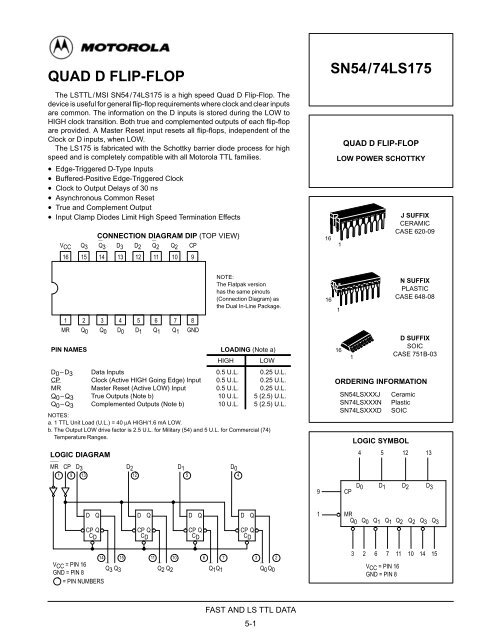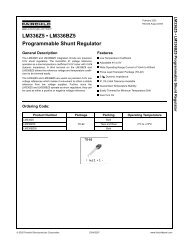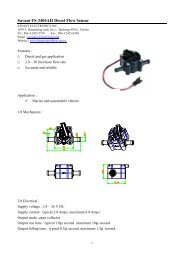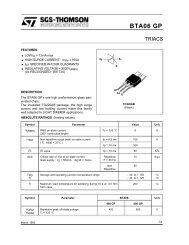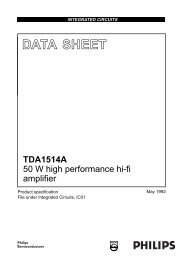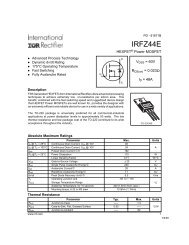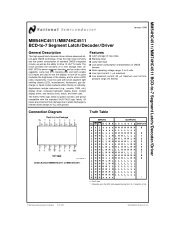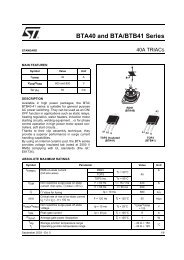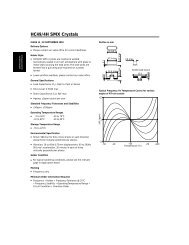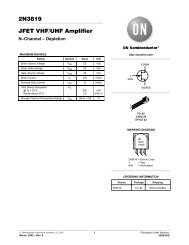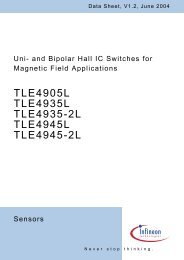QUAD D FLIP-FLOP SN54/74LS175
QUAD D FLIP-FLOP SN54/74LS175
QUAD D FLIP-FLOP SN54/74LS175
You also want an ePaper? Increase the reach of your titles
YUMPU automatically turns print PDFs into web optimized ePapers that Google loves.
<strong>QUAD</strong> D <strong>FLIP</strong>-<strong>FLOP</strong><br />
<strong>SN54</strong>/<strong>74LS175</strong><br />
The LSTTL/MSI <strong>SN54</strong>/<strong>74LS175</strong> is a high speed Quad D Flip-Flop. The<br />
device is useful for general flip-flop requirements where clock and clear inputs<br />
are common. The information on the D inputs is stored during the LOW to<br />
HIGH clock transition. Both true and complemented outputs of each flip-flop<br />
are provided. A Master Reset input resets all flip-flops, independent of the<br />
Clock or D inputs, when LOW.<br />
The LS175 is fabricated with the Schottky barrier diode process for high<br />
speed and is completely compatible with all Motorola TTL families.<br />
• Edge-Triggered D-Type Inputs<br />
• Buffered-Positive Edge-Triggered Clock<br />
• Clock to Output Delays of 30 ns<br />
• Asynchronous Common Reset<br />
• True and Complement Output<br />
• Input Clamp Diodes Limit High Speed Termination Effects<br />
VCC<br />
16 15<br />
CONNECTION DIAGRAM DIP (TOP VIEW)<br />
Q3 Q3 D3 D2 Q2 Q2 CP<br />
14 13 12 11 10 9<br />
16<br />
<strong>QUAD</strong> D <strong>FLIP</strong>-<strong>FLOP</strong><br />
LOW POWER SCHOTTKY<br />
1<br />
J SUFFIX<br />
CERAMIC<br />
CASE 620-09<br />
1 2 3 4 5 6 7 8<br />
MR Q0 Q0 D0 D1 Q1 Q1 GND<br />
NOTE:<br />
The Flatpak version<br />
has the same pinouts<br />
(Connection Diagram) as<br />
the Dual In-Line Package.<br />
PIN NAMES LOADING (Note a)<br />
HIGH LOW<br />
D0–D3<br />
CP<br />
MR<br />
Q0–Q3<br />
Q0–Q3<br />
Data Inputs<br />
Clock (Active HIGH Going Edge) Input<br />
Master Reset (Active LOW) Input<br />
True Outputs (Note b)<br />
Complemented Outputs (Note b)<br />
0.5 U.L.<br />
0.5 U.L.<br />
0.5 U.L.<br />
10 U.L.<br />
10 U.L.<br />
0.25 U.L.<br />
0.25 U.L.<br />
0.25 U.L.<br />
5 (2.5) U.L.<br />
5 (2.5) U.L.<br />
NOTES:<br />
a. 1 TTL Unit Load (U.L.) = 40 µA HIGH/1.6 mA LOW.<br />
b. The Output LOW drive factor is 2.5 U.L. for Military (54) and 5 U.L. for Commercial (74)<br />
b. Temperature Ranges.<br />
LOGIC DIAGRAM<br />
MR CP D3 D2 D1 D0<br />
1 9 13<br />
12<br />
5<br />
4<br />
16<br />
1<br />
16<br />
1<br />
N SUFFIX<br />
PLASTIC<br />
CASE 648-08<br />
ORDERING INFORMATION<br />
<strong>SN54</strong>LSXXXJ<br />
SN74LSXXXN<br />
SN74LSXXXD<br />
Ceramic<br />
Plastic<br />
SOIC<br />
LOGIC SYMBOL<br />
D SUFFIX<br />
SOIC<br />
CASE 751B-03<br />
4 5 12 13<br />
9 CP D 0 D1 D2 D3<br />
D<br />
Q<br />
D<br />
Q<br />
D<br />
Q<br />
D<br />
Q<br />
1<br />
MR<br />
Q 0 Q0 Q1 Q1 Q2 Q2 Q3 Q3<br />
CP<br />
C DQ<br />
CP<br />
C DQ<br />
CP<br />
C DQ<br />
CP<br />
C DQ<br />
14 15<br />
VCC = PIN 16<br />
GND = PIN 8<br />
Q3 Q3<br />
= PIN NUMBERS<br />
11<br />
Q2 Q2<br />
10<br />
6 7 3<br />
Q1 Q1<br />
Q0 Q0<br />
2<br />
3 2 6 7 11 10 14 15<br />
VCC = PIN 16<br />
GND = PIN 8<br />
FAST AND LS TTL DATA<br />
5-1
<strong>SN54</strong>/<strong>74LS175</strong><br />
FUNCTIONAL DESCRIPTION<br />
The LS175 consists of four edge-triggered D flip-flops with<br />
individual D inputs and Q and Q outputs. The Clock and<br />
Master Reset are common. The four flip-flops will store the<br />
state of their individual D inputs on the LOW to HIGH Clock<br />
(CP) transition, causing individual Q and Q outputs to follow. A<br />
LOW input on the Master Reset (MR) will force all Q outputs<br />
LOW and Q outputs HIGH independent of Clock or Data<br />
inputs.<br />
The LS175 is useful for general logic applications where a<br />
common Master Reset and Clock are acceptable.<br />
TRUTH TABLE<br />
Inputs (t = n, MR = H) Outputs (t = n+1) Note 1<br />
D Q Q<br />
L L H<br />
H H L<br />
Note 1: t = n + 1 indicates conditions after next clock.<br />
GUARANTEED OPERATING RANGES<br />
Symbol Parameter Min Typ Max Unit<br />
VCC Supply Voltage 54<br />
74<br />
4.5<br />
4.75<br />
5.0<br />
5.0<br />
5.5<br />
5.25<br />
V<br />
TA Operating Ambient Temperature Range 54<br />
74<br />
–55<br />
0<br />
25<br />
25<br />
125<br />
70<br />
°C<br />
IOH Output Current — High 54, 74 –0.4 mA<br />
IOL Output Current — Low 54<br />
74<br />
4.0<br />
8.0<br />
mA<br />
DC CHARACTERISTICS OVER OPERATING TEMPERATURE RANGE (unless otherwise specified)<br />
Limits<br />
Symbol Parameter Min Typ Max Unit Test Conditions<br />
i<br />
VIH Input HIGH Voltage 2.0 V<br />
VIL<br />
Input LOW Voltage<br />
54 0.7<br />
74 0.8<br />
V<br />
Guaranteed Input HIGH Voltage for<br />
All Inputs<br />
Guaranteed Input LOW Voltage for<br />
All Inputs<br />
VIK Input Clamp Diode Voltage –0.65 –1.5 V VCC = MIN, IIN = – 18 mA<br />
VOH<br />
VOL<br />
Output HIGH Voltage<br />
Output LOW Voltage<br />
54 2.5 3.5 V VCC = MIN, IOH = MAX, VIN = VIH<br />
74 2.7 3.5 V<br />
or VIL per Truth Table<br />
54, 74 0.25 0.4 V IOL = 4.0 mA VCC = VCC MIN,<br />
VIN =VIL or VIH<br />
74 0.35 0.5 V IOL = 8.0 mA per Truth Table<br />
IIH<br />
Input HIGH Current<br />
20 µA VCC = MAX, VIN = 2.7 V<br />
0.1 mA VCC = MAX, VIN = 7.0 V<br />
IIL Input LOW Current –0.4 mA VCC = MAX, VIN = 0.4 V<br />
IOS Short Circuit Current (Note 1) –20 –100 mA VCC = MAX<br />
ICC Power Supply Current 18 mA VCC = MAX<br />
Note 1: Not more than one output should be shorted at a time, nor for more than 1 second.<br />
FAST AND LS TTL DATA<br />
5-2
<strong>SN54</strong>/<strong>74LS175</strong><br />
AC CHARACTERISTICS (TA = 25°C)<br />
Limits<br />
Symbol Parameter Min Typ Max Unit Test Conditions<br />
i<br />
fMAX Maximum Input Clock Frequency 30 40 MHz<br />
tPLH<br />
tPHL<br />
tPLH<br />
tPHL<br />
Propagation Delay, MR to Output<br />
Propagation Delay, Clock to Output<br />
20<br />
20<br />
13<br />
16<br />
30<br />
30<br />
25<br />
25<br />
ns<br />
ns<br />
VCC = 5.0 V<br />
CL = 15 pF<br />
AC SETUP REQUIREMENTS (TA = 25°C)<br />
Symbol Parameter Min<br />
Limits<br />
Typ Max Unit Test Conditions<br />
i<br />
tW Clock or MR Pulse Width 20 ns<br />
ts Data Setup Time 20 ns<br />
th Data Hold Time 5.0 ns<br />
VCC =50V<br />
5.0 trec Recovery Time 25 ns<br />
AC WAVEFORMS<br />
1/fmax t w<br />
CP<br />
1.3 V<br />
ts(H)<br />
th(H) t s(L)<br />
1.3 V<br />
th(L)<br />
MR<br />
tW<br />
1.3 V<br />
1.3 V<br />
trec<br />
D<br />
Q<br />
Q<br />
*<br />
1.3 V<br />
1.3 V 1.3 V<br />
tPLH<br />
tPHL<br />
1.3 V 1.3 V<br />
tPHL<br />
tPLH<br />
1.3 V 1.3 V<br />
CP<br />
Q<br />
Q<br />
tPLH<br />
tPHL<br />
1.3 V<br />
1.3 V<br />
1.3 V<br />
1.3 V<br />
1.3 V<br />
*The shaded areas indicate when the input is permitted to<br />
*change for predictable output performance.<br />
Figure 1. Clock to Output Delays, Clock Pulse Width,<br />
Frequency, Setup and Hold Times Data to Clock<br />
Figure 2. Master Reset to Output Delay, Master Reset<br />
Pulse Width, and Master Reset Recovery Time<br />
DEFINITIONS OF TERMS<br />
SETUP TIME (ts) — is defined as the minimum time required<br />
for the correct logic level to be present at the logic input prior to<br />
the clock transition from LOW to HIGH in order to be recognized<br />
and transferred to the outputs.<br />
HOLD TIME (th) — is defined as the minimum time following<br />
the clock transition from LOW to HIGH that the logic level must<br />
be maintained at the input in order to ensure continued recognition.<br />
A negative HOLD TIME indicates that the correct logic<br />
level may be released prior to the clock transition from LOW to<br />
HIGH and still be recognized.<br />
RECOVERY TIME (trec) — is defined as the minimum time<br />
required between the end of the reset pulse and the clock<br />
transition from LOW to HIGH in order to recognize and transfer<br />
HIGH Data to the Q outputs.<br />
FAST AND LS TTL DATA<br />
5-3


